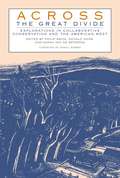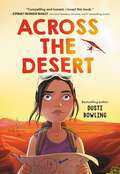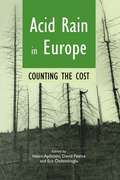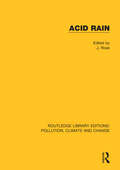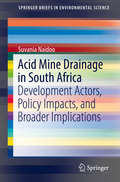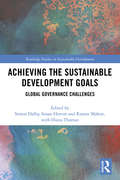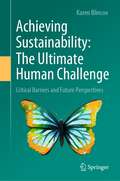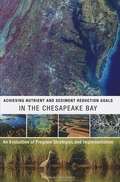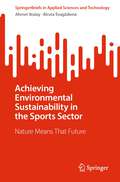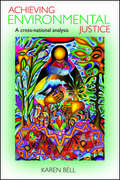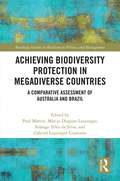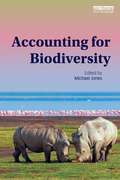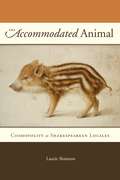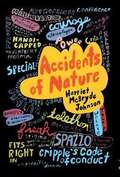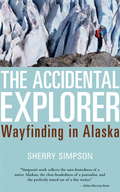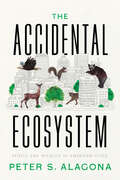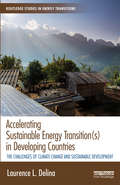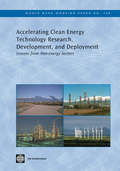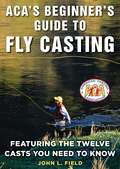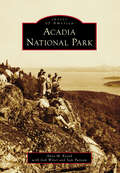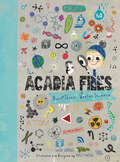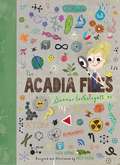- Table View
- List View
Across the Great Divide: Explorations In Collaborative Conservation And The American West
by Daniel Kemmis Sarah F. Bates Philip Brick Donald SnowAmid the policy gridlock that characterizes most environmental debates, a new conservation movement has emerged. Known as "collaborative conservation," it emphasizes local participation, sustainability, and inclusion of the disempowered, and focuses on voluntary compliance and consent rather than legal and regulatory enforcement. Encompassing a wide range of local partnerships and initiatives, it is changing the face of resource management throughout the western United States.Across the Great Divide presents a thoughtful exploration of this new movement, bringing together writing, reporting, and analysis of collaborative conservation from those directly involved in developing and implementing the approach. Contributors examine: the failure of traditional policy approaches recent economic and demographic changes that serve as a backdrop for the emergence of the movement the merits of, and drawbacks to, collaborative decision-making the challenges involved with integrating diverse voices and bringing all sectors of society into the movement .In addition, the book offers in-depth stories of eight noteworthy collaborative initiatives -- including the Quincy Library Group, Montana's Clark Fork River, the Applegate Partnership, and the Malpai Borderlands -- that explore how different groups have organized and acted to implement their goals.Among the contributors are Ed Marston, George Cameron Coggins, David Getches, Andy Stahl, Maria Varela, Luther Propst, Shirley Solomon, William Riebsame, Cassandra Moseley, Lynn Jungwirth, and others. Across the Great Divide is an important work for anyone involved with collaborative conservation or the larger environmental movement, and for all those who care about the future of resource management in the West.
Across the Desert
by Dusti BowlingOne girl sets out on a journey across the treacherous Arizona desert to rescue a young pilot stranded after a plane crash in this gripping story of survival, friendship, and rescue from a bestselling and award-winning author.Twelve-year-old Jolene spends every day she can at the library watching her favorite livestream: The Desert Aviator, where twelve-year-old &“Addie Earhart&” shares her adventures flying an ultralight plane over the desert. While watching this daring girl fly through the sky, Jolene can dream of what it would be like to fly with her, far away from her own troubled home life where her mother struggles with a narcotic addiction. And Addie, who is grieving the loss of her father, finds solace in her online conversations with Jolene, her biggest—and only—fan.Then, one day, it all goes wrong: Addie's engine abruptly stops, and Jolene watches in helpless horror as the ultralight plummets to the ground and the video goes dark. Jolene knows that Addie won&’t survive long in the extreme summer desert heat. With no one to turn to for help and armed with only a hand-drawn map and a stolen cell phone, it's up to Jolene to find a way to save the Desert Aviator. Packed with adventure and heart, Across the Desert speaks to the resilience, hope, and strength within each of us.
Acid Rain in Europe: Counting the cost (Earthscan Library Collection: International Environmental Governance Set Ser.)
by David Pearce Helen ApSimon Ece ÖzdemirogluThe environmental impacts of acid rain: on human health, on buildings and materials, on forests, freshwaters, crops and biodiversity and on global warming have been well-documented. Less is known about the extent and economic costs of these impacts. This book describes the first major implementation of an integrated scientific and economic assessment of the consequences of acid rain. It provides an extensive data review and examines how this unique approach to assessment modelling can be can be used to calculate an acidification cost per unit of pollutant in monetary terms. Part One focuses on the methodological issues of scientific measurement of acidification, dose-response relationships and economic approaches to acidification control. Part Two looks at the environmental impacts and economic consequences of acidification. Affected environmental media and human health are investigated in separate chapters, each including both scientific and economic analyses. Part Three provides a summary of the findings and makes recommendations for further application of these types of results to policy actions.
Acid Rain
by J. RoseOriginally published in 1994 this volume includes contributions from environmental scientists, consultants and research workers. The incidence and effects of the phenomenon of acid rain in the late 1970s, 80s and early 1990s , as well as certain remedies, are discussed at length. The roles of vehicles and power stations are examined in detail and legal aspects of curbing acid rain are considered.
Acid Mine Drainage in South Africa: Development Actors, Policy Impacts, and Broader Implications (SpringerBriefs in Environmental Science)
by Suvania NaidooThis SpringerBrief focuses on Acid Mine Drainage (AMD) in the three basins in the Witwatersrand, South Africa. It provides a background to AMD and its impactsfrom a social science perspective. The South African government and non-governmental organizations' response to AMD is assessed, as well the socio-economic and developmental effects of AMD. This volume, which is based on the author's Master's dissertation at UNISA, involves interviews with a range of experts in the field from government departments, environmental organisations (activists), the private sector (mining), tourism sector and the agricultural sector. The book discusses existing policy documents on AMD and provides recommendations in response to the many socio-economic impacts which have not been fully addressed. A literature review on the global context of AMD is provided. South Africa's water systems are already severely harmed by climate change, different forms of pollution, and poorly managed sanitation systems. For these reasons, the country is becoming increasingly water-stressed and therefore, water will continue to become much scarcer in the future. As a result of AMD's continued impact on South Africa's water systems, as a technical or scientific matter as well as the policy implications for the mining sector, water security and socio-economic sustainability has become a highly contested issue.
Achieving the Sustainable Development Goals: Global Governance Challenges (Routledge Studies in Sustainable Development)
by Simon Dalby Susan Horton Rianne Mahon Diana ThomazThis book draws on the expertise of faculty and colleagues at the Balsillie School of International Affairs to both locate the Sustainable Development Goals (SDGs) as a contribution to the development of global government and to examine the political-institutional and financial challenges posed by the SDGs. The contributors are experts in global governance issues in a broad variety of fields ranging from health, food systems, social policy, migration and climate change. An introductory chapter sets out the broad context of the governance challenges involved, and how individual chapters contribute to the analysis. The book begins by focusing on individual SDGs, examining briefly the background to the particular goal and evaluating the opportunities and challenges (particularly governance challenges) in achieving the goal, as well as discussing how this goal relates to other SDGs. The book goes on to address the broader issues of achieving the set of goals overall, examining the novel financing mechanisms required for an enterprise of this nature, the trade-offs involved (particularly between the urgent climate agenda and the social/economic goals), the institutional arrangements designed to enable the achievement of the goals and offering a critical perspective on the enterprise as a whole. Achieving the Sustainable Development Goals makes a distinctive contribution by covering a broad range of individual goals with contributions from experts on governance in the global climate, social and economic areas as well as providing assessments of the overall project – its financial feasibility, institutional requisites, and its failures to tackle certain problems at the core. This book will be of great interest to scholars and students of international affairs, development studies and sustainable development, as well as those engaged in policymaking nationally, internationally and those working in NGOs.
Achieving Sustainability: Critical Barriers and Future Perspectives
by Karen BlincoeThe book provides an assessment of whether sustainability is realizable in the current societal framework. What are the challenges and the barriers - and what are the levers necessary to meet and overcome them?Through a revision of the essence of sustainability the book provides an opportunity to understand the deeper level of the radical change that sustainability represents, and the resistance that is preventing its realization.To build the argument the sustainable development model is compared with current development theories as well as alternative solutions based on utopian models of the past. The book assesses the results that can be achieved within the current systemic framework, based on case stories. It outlines the limitations to sustainability, pointing out and defining the multiple, cross-sectoral and systemic barriers that hinder the transition.Finally, the book offers perspectives on achieving a sustainable future, encompassing the impacts from recent events including the pandemic as well as the multiple mitigation and transition initiatives undertaken globally.Brian Goodwin's QuoteLike the caterpillar that wraps itself up in its silken swaddling bands prior to its metamorphosis into a butterfly, we have wrapped ourselves in a tangled skin from which we can emerge only by going through a similarly dramatic transformation.
Achieving Nutrient and Sediment Reduction Goals in the Chesapeake Bay: An Evaluation of Program Strategies and Implementation
by The National Academy of SciencesThe Chesapeake Bay is North America's largest and most biologically diverse estuary, as well as an important commercial and recreational resource. However, excessive amounts of nitrogen, phosphorus, and sediment from human activities and land development have disrupted the ecosystem, causing harmful algae blooms, degraded habitats, and diminished populations of many species of fish and shellfish. In 1983, the Chesapeake Bay Program (CBP) was established, based on a cooperative partnership among the U. S. Environmental Protection Agency (EPA), the state of Maryland, and the commonwealths of Pennsylvania and Virginia, and the District of Columbia, to address the extent, complexity, and sources of pollutants entering the Bay. In 2008, the CBP launched a series of initiatives to increase the transparency of the program and heighten its accountability and in 2009 an executive order injected new energy into the restoration. In addition, as part of the effect to improve the pace of progress and increase accountability in the Bay restoration, a two-year milestone strategy was introduced aimed at reducing overall pollution in the Bay by focusing on incremental, short-term commitments from each of the Bay jurisdictions. The National Research Council (NRC) established the Committee on the Evaluation of Chesapeake Bay Program Implementation for Nutrient Reduction in Improve Water Quality in 2009 in response to a request from the EPA. The committee was charged to assess the framework used by the states and the CBP for tracking nutrient and sediment control practices that are implemented in the Chesapeake Bay watershed and to evaluate the two-year milestone strategy. The committee was also to assess existing adaptive management strategies and to recommend improvements that could help CBP to meet its nutrient and sediment reduction goals. The committee did not attempt to identify every possible strategy that could be implemented but instead focused on approaches that are not being implemented to their full potential or that may have substantial, unrealized potential in the Bay watershed. Because many of these strategies have policy or societal implications that could not be fully evaluated by the committee, the strategies are not prioritized but are offered to encourage further consideration and exploration among the CBP partners and stakeholders.
Achieving Environmental Sustainability in the Sports Sector: Nature Means That Future (SpringerBriefs in Applied Sciences and Technology)
by Ahmet Atalay Biruta ŠvagždienėThis book explores the previously overlooked negative environmental impact of the sports industry, with a particular emphasis on the carbon footprint of sports facilities and organizations. The authors provide a comprehensive assessment of sustainable development goals, economic, social, and environmental sustainability concepts. They reveal the significant negative effects that the sports sector has on the environment and examine the policies implemented by stakeholders in the industry.The book also explores a case study of the legal policies implemented by the Lithuanian government to reduce the environmental impact of sports. The authors present practical suggestions for environmentally-friendly sports management, supported by examples presented with figures, pictures, and tables.This book fills a gap in the literature, offering suggestions and comments to enrich the practices of stakeholders in the sports industry. It provides an opportunity to make a positive difference for the environment while advancing the field of sports management.
Achieving Environmental Justice: A Cross-National Analysis
by Karen BellEnvironmental justice aspires to a healthy environment for all, as well as fair and inclusive processes of environmental decision-making. In order to develop successful strategies to achieve this, it is important to understand the factors that shape environmental justice outcomes. This optimistic, accessible and wide-ranging book contributes to this understanding by assessing the extent of, and reasons for, environmental justice/injustice in seven diverse countries - United States, Republic of Korea (South Korea), United Kingdom, Sweden, China, Bolivia and Cuba. Factors discussed include: race and class discrimination; citizen power; industrialisation processes; political-economic context; and the influence of dominant environmental discourses. In particular, the role of capitalism is critically explored. Based on over a hundred interviews with politicians, experts, activists and citizens of these countries, this is a compelling analysis aimed at all academics, policy-makers and campaigners who are engaged in thinking or action to address the most urgent environmental and social issues of our time.
Achieving Biodiversity Protection in Megadiverse Countries: A Comparative Assessment of Australia and Brazil (Routledge Studies in Biodiversity Politics and Management)
by Paul Martin Márcia Dieguez Leuzinger Solange Teles da Silva Gabriel Leunziger CoutinhoThis volume systematically analyses why legal doctrines for the protection of biodiversity are not sufficiently effective. It examples implementation in Australia and Brazil, two megadiverse countries with very differing legal and cultural traditions and natural environments. Substantial effort goes into the development and interpretation of legal doctrines for the protection of biodiversity in national and international law. Despite this, biodiversity continues in steep decline. Nowhere is this more evident than in megadiverse countries, such as Australia and Brazil, which possess the greatest number and diversity of animals and plants on Earth. The book covers a wide range of topics, including farming, mining, marine environments, indigenous interests and governance. Achieving Biodiversity Protection in Megadiverse Countries highlights specific causes of underperformance in protecting diverse terrestrial and marine environments. It provides proposals for more effective implementation in these two jurisdictions, relevant to other megadiverse territories, and for biodiversity protection generally. Each chapter was written by teams of Australian and Brazilian authors, so that similar issues are considered across both jurisdictions, to provide both country-specific and generalisable insights. Achieving Biodiversity Protection in Megadiverse Countries will be of great interest to students and scholars of environmental law and governance and biodiversity conservation, as well as policymakers, practitioners and NGOs working in these fields.
Accounting for Carbon
by Bellassen, Valentin and Stephan, Nicolas Valentin Bellassen Nicolas StephanThe ability to accurately monitor, record, report and verify greenhouse gas emissions is the cornerstone of any effective policy to mitigate climate change. Accounting for Carbon provides the first authoritative overview of the monitoring, reporting and verification (MRV) of emissions from the industrial site, project and company level to the regional and national level. It describes the MRV procedures in place in more than fifteen of the most important policy frameworks - such as emissions trading systems in Europe, Australia, California and China, and the United Nations Framework Convention on Climate Change - and compares them along key criteria such as scope, cost, uncertainty and flexibility. This book draws on the work of engineers and economists to provide a practical guide to help government and non-governmental policy makers and key stakeholders in industry to better understand different MRV requirements, the key trade-offs faced by regulators and the choices made by up-and-running carbon pricing initiatives.
Accounting for Biodiversity: Accounting For Biodiversity
by Michael Jones‘Biodiversity’ at its simplest, refers to the variety of species inhabiting Planet Earth. It is essential to the well-being of the planet. There is now a scientific consensus around the current ongoing crisis in biodiversity arising from both climate change and human activities. Experts believe we are in the middle of a mass extinction of biodiversity with devastating consequences for our planet. Accounting for Biodiversity explores the need for companies to actively protect, conserve and improve biodiversity within their sphere of operation. The 14 chapters written by a selected team of experts investigate the ways in which companies are embracing their responsibility through a variety of biodiversity initiatives and innovative models designed to improve the recording, reporting and valuing of biodiversity. Global case studies look at biodiversity accounting in Africa, Asia, Australasia, Europe and South America. Overall, this book provides a comprehensive set of reflections on accounting for biodiversity and recommendations for the future. This book is essential reading for all those interested in the contribution that accounting can make to the preservation of biodiversity. As we see increasing awareness of the importance of sustainability and ecological responsibility in business activity it is relevant and should prove informative to students, managers, accountants and those in business more generally. It is also important for all those interested in conserving biodiversity.
Accomplishing Climate Governance
by Harriet BulkeleyThis book provides a new approach to thinking about the politics and geographies of climate governance. It argues that in order to understand the nature and potential of the range of new responses to climate change emerging at multiple scales we need to examine how governance is accomplished - how it is undertaken, practised and contested. Through a range of case studies drawn from communities, corporations and local government, the book examines how climate change comes to be governed and made to matter as an issue with which diverse publics should be concerned. It concludes that rather than seeking the solution to climate change once and for all, we need to engage with the ways in which we can channel our intentions to ameliorate the climate problem to more progressive ends. The book will be of interest to researchers, advanced students and policy makers across the social sciences.
The Accommodated Animal: Cosmopolity in Shakespearean Locales
by Laurie ShannonShakespeare wrote of lions, shrews, horned toads, curs, mastiffs, and hellhounds. But the word OC animalOCO itself only appears very rarely in his work, which was in keeping with sixteenth-century usage. As Laurie Shannon reveals in "The Accommodated Animal," the modern human / animal divide first came strongly into play in the seventeenth century, with DescartesOCOs famous formulation that reason sets humans above other species: OC I think, therefore I am. OCO Before that moment, animals could claim a firmer place alongside humans in a larger vision of belonging, or what she terms cosmopolity. aWith Shakespeare as her touchstone, Shannon explores the creaturely dispensation that existed until Descartes. She finds that early modern writers used classical natural history and readings of Genesis to credit animals with various kinds of stakeholdership, prerogative, and entitlement, employing the language of politics in a constitutional vision of cosmic membership. Using this political idiom to frame cross-species relations, Shannon argues, carried with it the notion that animals possess their own investments in the world, a point distinct from the question of whether animals have reason. It also enabled a sharp critique of the tyranny of humankind. By answering OC the question of the animalOCO historically, "The Accommodated Animal" makes a brilliant contribution to cross-disciplinary debates engaging animal studies, political theory, intellectual history, and literary studies. "
Accidents of Nature
by Harriet Mcbryde JohnsonJean has cerebral palsy and gets around in a wheelchair, but she's always believed she's just the same as everyone else. She goes to normal school and has normal friends She's never really known another disabled person before she arrives at Camp Courage. But there Jean meets Sara, who welcomes her to "Crip Camp" and nicknames her Spazzo. Sara has radical theories about how people fit into society. She's full of rage and revolution against pitying insults and the lack of respect for people with disabilities. As Jean joins a community unlike any she has ever imagined, she comes to question her old beliefs and look at the world in a new light. The camp session is only ten days long, but that may be all it takes to change a life forever.
Accidental Wilderness: The Origins and Ecology of Toronto’s Tommy Thompson Park
by Walter H. KehmOnce referred to as Toronto’s “accidental wilderness,” Tommy Thompson Park is now recognized as a fortuitous urban miracle. Initially created as a landfill site on the city’s rapidly developing waterfront, the park’s physical and ecological footprint have grown dramatically. Forests, grasslands, and wildlife now thrive – all within a stone’s throw of some of the most densely populated areas of North America’s fourth-largest city. Accidental Wilderness is a rich and lyrical collection of essays curated by internationally recognized landscape architect and original designer of Tommy Thompson Park, Walter H. Kehm, complemented by a stunning collection of photographs by renowned landscape photographer Robert Burley. The book explores the city’s port origins; the park’s master plan principles and design; the native-plant succession process; the park’s unique flora and fauna; public advocacy; and public recreation in the park and its effect on mental, physical, and spiritual health. In an era where the looming dangers associated with climate change affect our daily lives, Tommy Thompson Park offers a hopeful narrative about how nature can flourish in, and contribute to, the well-being of twenty-first-century cities.
The Accidental Explorer: Wayfinding in Alaska
by Sherry SimpsonAlaska is a place of great adventure and exploration. After having lived in the Great Land for nearly all of her life, Sherry Simpson realized that she had not scaled mountains, trekked across wild tundra, or blazed trails through virgin forests. Did that fact make her less of an Alaskan? In the series of essays that comprise The Accidental Explorer, Sherry Simpson recounts the experiences of an ordinary woman confronting the great expanses of water and untracked land in Alaska, as she makes her best efforts to map her sense of place and her sense of self in a land that seems to require exploration of its inhabitants. While undertaking arduous treks into the backcountry, she falls into a glacial river and nearly drowns. On an archetypal epic solo hike, she ruminates constantly on when and whether she should abandon that folly. She writes with both humor and humility, harnessing great powers of observation of the natural world. In a downright scary encounter with a mildly aggressive bear, Simpson shrinks from any supposed Alaskan larger-than-life persona to assume her place on the food chain: an urbanized human who is appropriately afraid of big bears. Simpson also offers up the (less reverent) Alaskan view of Chris McCandles, the wanderer who perished in an abandoned bus near Denali, subject of Into the Wild by Jon Krakauer. Can an ordinary, not especially heroic, person be an adventurer? If she sets out, in a wild place like Alaska, what will she find out there, and what will she learn about the place back home? Throughout this compelling and probing book, Sherry Simpson illuminates the act of exploration as both a feat of extraordinary effort and as an everyday experience.
The Accidental Ecosystem: People and Wildlife in American Cities
by Peter S. AlagonaWith wildlife thriving in cities, we have the opportunity to create vibrant urban ecosystems that serve both people and animals.The Accidental Ecosystem tells the story of how cities across the United States went from having little wildlife to filling, dramatically and unexpectedly, with wild creatures. Today, many of these cities have more large and charismatic wild animals living in them than at any time in at least the past 150 years. Why have so many cities—the most artificial and human-dominated of all Earth’s ecosystems—grown rich with wildlife, even as wildlife has declined in most of the rest of the world? And what does this paradox mean for people, wildlife, and nature on our increasingly urban planet? The Accidental Ecosystem is the first book to explain this phenomenon from a deep historical perspective, and its focus includes a broad range of species and cities. Cities covered include New York City, Los Angeles, San Francisco, Pittsburgh, Austin, Miami, Chicago, Seattle, San Diego, Atlanta, Philadelphia, and Baltimore. Digging into the natural history of cities and unpacking our conception of what it means to be wild, this book provides fascinating context for why animals are thriving more in cities than outside of them. Author Peter S. Alagona argues that the proliferation of animals in cities is largely the unintended result of human decisions that were made for reasons having little to do with the wild creatures themselves. Considering what it means to live in diverse, multispecies communities and exploring how human and non-human members of communities might thrive together, Alagona goes beyond the tension between those who embrace the surge in urban wildlife and those who think of animals as invasive or as public safety hazards. The Accidental Ecosystem calls on readers to reimagine interspecies coexistence in shared habitats, as well as policies that are based on just, humane, and sustainable approaches.
Accelerating Sustainable Energy Transition: The challenges of climate change and sustainable development (Routledge Studies in Energy Transitions)
by Laurence L DelinaAccelerating sustainable energy transitions away from carbon-based fuel sources needs to be high on the agendas of developing countries. It is key in achieving their climate mitigation promises and sustainable energy development objectives. To bring about rapid transitions, simultaneous turns are imperative in hardware deployment, policy improvements, financing innovation, and institutional strengthening. These systematic turns, however, incur tensions when considering the multiple options available and the disruptions of entrenched power across pockets of transition innovations. These heterogeneous contradictions and their trade-offs, and uncertainties and risks have to be systematically recognized, understood, and weighed when making decisions. This book explores how the transitions occur in fourteen developing countries and broadly surveys their technological, policy, financing, and institutional capacities in response to the three key aspects of energy transitions: achieving universal energy access, harvesting energy efficiency, and deploying renewable energy. The book shows how fragmented these approaches are, how they occur across multiple levels of governance, and how policy, financing, and institutional turns could occur in these complex settings. This book will be of interest to students and scholars of energy and climate policy, development studies, international relations, politics, strategic studies, and geography. It is also useful to policymakers and development practitioners.
Accelerating Clean Energy Technology Research, Development, and Deployment
by Jonathan Coony Patrick AvatoClimate change is one of the key challenges of this century. At the same time, energy use-the primary source of climate-altering global greenhouse gas emissions-is increasing at unprecedented rates and is vital to the continued economic growth of developing countries. This poses a serious dilemma that can only be reconciled with new and improved clean energy technologies that balance climate change mitigation and increased energy needs in developing countries. Despite a recent increase in investment, public and private research, development, and deployment (RD&D) funding rates are well below historical levels. In addition, significant barriers impede the ability to develop new technologies, such as the uncertain future value of CO2 emissions, intellectual property rights issues, limited incentives to commercialize technologies for developing countries, and challenges with technology transfer. These factors must be overcome to accelerate innovation in the energy sector. To introduce new thinking to address these concerns, this report examines four cases from outside the energy sector where creative approaches to RD&D have successfully overcome similar barriers. The case studies review approaches to innovation by the Consultative Group on International Agricultural Research, Advanced Market Commitments for Vaccines, the Human Genome Project, and the concept of Distributed Innovation. These case studies show how creative efforts can generate valuable public goods via: (i) international partnerships between public and private actors, (ii) information sharing and intellectual property rights, and (iii) novel financing schemes.
ACA's Beginner's Guide to Fly Casting: Featuring the Twelve Casts You Need to Know
by John L. FieldIn The ACA's Beginner's Guide to Fly Casting: Featuring the Twelve Casts You Need to Know, John Field, tournament caster and FFI Master Casting Instructor, teaches and explains the fundamentals of fly casting, step by step. John shares the casting games of the American Casting Association and its 110 years of proven methods. This guide also includes learning tips from champion casters Steve Rajeff and Chris Korich. To begin, Field carefully lays out the essentials for getting ready, like assembling an outfit, and caring for your tackle. Next, he shows the simplest but most efficient way to start casting and practicing for results. Once you can make the basic cast, the next chapters provide the steps to achieve casting accuracy and distance. Whether learning to fly fish in fresh or saltwater, Field's expertise is sure to have you casting like a pro before you know it. With expert instructions, accompanying diagrams and fun drills, The ACA's Beginner's Guide to Fly Casting will help the next generation of flyfishers participate in this wonderful sport.
Acadia National Park (Images of America)
by Anne M. Kozak Josh Winer Sam PutnamMost histories of Acadia National Park chronicle the contributions of men in acquiring land, and while these contributions were critical, women also played a pivotal role. Some funded memorial paths, others facilitated George Dorr's acquiring land, and still others donated land. For people to enjoy the park and to find respite required developing infrastructure that provided easy access--a goal of Dorr, John D. Rockefeller Jr., and National Park Service directors Stephen Mather and Arno Cammerer. This book examines the role of women, the activities that characterize people enjoying the park, and the development of infrastructure, particularly the bridges and motor roads. Having access to two private photograph collections--those of the van Heerden family and Harold MacQuinn Inc.--as well as the photograph collection of Leo Grossman, the engineer for the Cadillac Mountain Road, has allowed us to use many previously unpublished images.
The Acadia Files: Book Three, Winter Science (The\acadia Files Ser. #1)
by Katie CoppensIn Book Three of the Acadia Files series, Acadia Greene carries her search for answers into winter. A melting snowman leads her—of course!—to explore climate change and how to reduce her carbon footprint. The helium balloons at her eleventh birthday party beg questions—naturally!—of molecular structure, weights of gases,and neutral buoyancy. An afternoon making paper airplanes brings discoveries in aerodynamics. Tracks in the snow raise questions of how animals survive the winter. And an afternoon of sledding slides right into an investigation of momentum, acceleration, and friction. Acadia doesn’t mean to do science—it just happens. She’s curious, determined, bold, and bright—a wonderful STEAM ambassador! The Acadia Files is a fun introduction to the wonders of science,using real-world scenarios to make scientific inquiry relatable and understandable. Parents and educators can use The Acadia Files to let kids discover for themselves what it’s like to be curious about the world and to satisfy that curiosity with scientific thinking.
The Acadia Files: The Summer Investigations (The Acadia Files #1)
by Katie Coppens Holly HatamThe Acadia Files: Summer Investigations presents five summer stories, each one followed by Acadia’s science notebook pages with her simple explanations and lively, whimsical drawings of natural phenomena. The Acadia Files is a fun introduction to the wonders of science, using real-world scenarios to make scientific inquiry relatable and understandable. Parents and educators can use The Acadia Files to let kids discover for themselves what it’s like to be curious about the world and to satisfy that curiosity with scientific thinking. Acadia Files for autumn, winter, and spring will follow on future lists. The Acadia Files: Summer Investigations offers an engaging new way to apply the scientific method to real-world scenarios. Great for teaching STEAM Acadia Greene wants answers. Who keeps stealing her blueberries just as they ripen on the bushes? Why is her hair curly? Why does the sun wake her up so early in the summer? Why does the tide submerge her sandcastles? How do rocks become sand? Acadia doesn’t set out to do science, but she has these important questions and her scientist parents refuse to simply feed her the answers. “Conduct an experiment,” they tell her. “Use the scientific method.” So Acadia gathers evidence, makes hypotheses, designs experiments, uses the results to test her hypotheses, and draws conclusions. Acadia does science.
